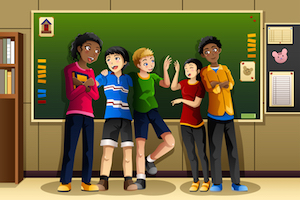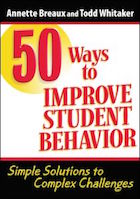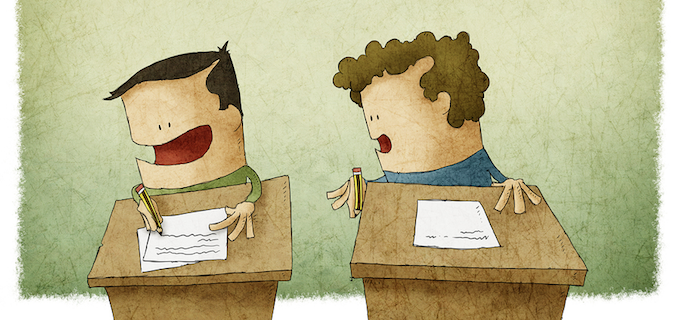Three Questions New Teachers Always Ask

We asked her to write about three of the most pressing questions new teachers have in the months and weeks before they open their classroom doors to students for the first time. Breaux, who is also known for her PD-oriented poetry, offers advice about discipline, classroom management, and establishing daily procedures.

Contrary to popular belief, discipline is NOT the number one problem in the classroom. Rather, the lack of clear, structured, well-rehearsed procedures and routines is what causes most discipline problems. From day one, effective teachers establish clear routines and procedures, and students are shown and told exactly what is expected of them.
Good discipline, good procedures, and good classroom management are inextricably linked, but let’s break them down for the new teacher.
Q1: What about student discipline?
In well-managed classrooms,
discipline problems are few and far between
And the teachers appear happy,
not disgruntled or mean.
Often, the terms discipline and classroom management are mistakenly used synonymously. Discipline is only one part of classroom management, albeit a vital one.
Your discipline plan (and you must have one) should consist of a set of a few rules. If a student breaks a rule, there is a definite consequence. This consequence is not contingent upon the frustration level of the teacher at the time the rule is broken, but rather is predetermined when the plan is being devised. Students are made aware of both the classroom rules and the consequences for not following those rules.
Rules are devised to set limits, to help maintain order, and to protect people. On our public highways, there are speed limits. If the limit is exceeded, there is a consequence: a speeding ticket. This consequence is predetermined. Motorists are aware of the consequences of exceeding the speed limit, just as students should be aware of the consequences of breaking rules in your classroom.
Devise a discipline plan and enforce it consistently. And please ensure that your rules cover serious offenses only. Teachers often get into trouble, creating discipline problems, when they post 10, 15, 20 or so rules for the class, many of which relate to minor offenses. An example would be talking, which is procedural in nature. (For a practically foolproof way of getting students to stop talking out of turn, read this excerpt from the third edition of my book 101 Answers.)
An example of a serious offense that would require a rule would be hitting others. Most teachers would agree that this is a serious offense, and that there should be a rule and consequence established to regulate this behavior.
Have you ever noticed that the very best teachers have very few discipline problems? The real key to their success does not lie in the way that they discipline their students after the rules have been broken. Rather, they have established ways of preventing most behavior problems through the structure of their classroom management plans along with their pleasant demeanors and proactive approaches to dealing with students.
The simple fact is that in a well-managed environment there are very few discipline problems. The classroom hums like a well-rehearsed choir!
Ask Yourself: Have I determined a few (no more than five) rules to regulate serious offenses in my classroom, and are my students aware of the consequences of breaking those rules?
Q2: How should I manage my classroom?
Without procedures and routines,
certain chaos intervenes.
But when students know exactly what’s expected,
behavior problems are often corrected.
Effective teachers are aware that the term “classroom management” refers to everything you do to make your classroom run smoothly: how you arrange the furniture to facilitate learning, how you expect students to enter and exit the classroom, where you stand when you are teaching to ensure that you are in close proximity to all of your students, how you pace your activities, how you establish expectations for student behavior, and so on. In other words, an effective teacher plans EVERYTHING.
If you want what all teachers want – to experience few discipline problems with your students – then it is important that you have a clear, concise classroom management plan. But please do not reinvent the wheel. Implement the basic tried-and-true management techniques of the most successful teachers. My books share many of these practical, common-sense “secrets.” And a quick online search will yield lots of free tips, checklists, and samples of effective management plans from fellow educators.
FACT: Just as a bus cannot transport students to school without tires, even if the bus is in perfect mechanical condition, a teacher cannot teach ANYTHING to students until classroom management is in place, even if he or she is knowledgeable about the content. Management is just as important to learning as tires are to getting a bus from point A to point B. Clearly, established procedures and routines are the most important part of any effective classroom management plan.
Ask Yourself: Am I clear on what I expect of my students, and do they know what is expected of them?
 Q3: What procedures do I need?
Q3: What procedures do I need?
For what kinds of things should procedures be set?
For anything you don’t want to regret!
Some activities lend themselves to creative expression. Others do not. Designing an automobile lends itself to creative expression. Assembling the automobile does not. On the design table, there are infinite options for how a particular automobile might be constructed. Once the final design hits the assembly line, there is now only ONE option: to follow the design plan exactly as stated.
The same is true for classroom management. In order to successfully manage a classroom of students or any group of people, clearly defined procedures – consistent ways of doing things – must be established.
Take 30 students and do not tell them how you want a task done. They will each create numerous ways to perform that task. Many of these ways will not work. Thirty students doing things their own way for even one task will allow for endless possibilities. This is good when teaching them how to think, but not so good when teaching them how to behave. You need to do both.
So what kinds of activities require procedures in the classroom? Any activity that does not lend itself to creative expression requires procedures. For instance, you would not want your students “creating” ways of entering your classroom, sharpening their pencils, turning in assignments, using personal electronic devices, moving into groups, or walking to the lunchroom.
As the person in charge of managing a group of students, it is your responsibility to establish procedures in order to ensure the smooth operation of your classroom environment. The following are a few examples of activities that require procedures:
- Entering the classroom.
- Exiting the classroom.
- Passing in papers.
- Asking for permission to speak.
- Knowing what to do with your book bag when you enter the classroom.
- Asking a question.
- Working cooperatively in groups.
- Working at computer stations.
- Knowing what to do in a school lock-down, fire, or severe weather situation.
- Knowing what to do if you have finished your work and others have not.
- Turning in homework assignments.
- Using personal electronic devices in acceptable ways at acceptable times, etc.
Tell your students what you expect, show them how you expect things to be done, practice the procedures with them, and reinforce as necessary.
And please remember that the act of practicing procedures is not something reserved for elementary students. Consider the fact that professional football teams practice the same procedures over and over and over, every day! Effective coaches, like effective teachers, recognize the importance of establishing and practicing procedures.

Instead, calmly say, “Oh, I see that a few of you have forgotten the procedure and need a little more practice.” And then practice, like it’s no big deal. Even if it IS a big deal to you, don’t let them know that. Remain calm and simply practice the procedure with them again. If only one student continues to “forget” to follow a specific procedure, simply hold a private practice session with that student (see Tip 19 from my book 101 Answers).
Please remember that not all procedures can be established and practiced in one day. What you’ll want to do is determine the most important procedures and practice those first. Once students are clear on those, add a few more. Just be careful not to overwhelm them with too many at a time because then you’ll be inviting chaos and confusion – the opposite of what procedures are designed to accomplish.
Ask Yourself: Do I have a list of procedures I expect my students to follow, have I determined which of those are of immediate importance, and am I establishing (and practicing) those procedures with my students on a consistent basis?








































I am so excited about teaching 8th grade social studies! I got some awesome tips.
Thank you!
Very nice tips, Ms. Breaux! Following these will likely cut any “discipline problems” about 80%.
Love your suggestion to stay calm and act like they forgot the rules, if violated. It does work! Also, when kids enter the classroom, plan to stand at the door and greet them. It sets the tone for the day or class period.